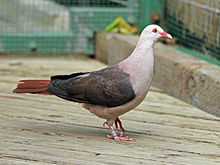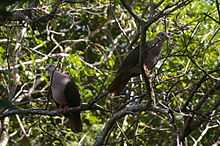Pink Pigeon
| Pink Pigeon | |
|---|---|
 | |
| At Birdworld, Surrey, England | |
| Conservation status | |
| Scientific classification | |
| Kingdom: | Animalia |
| Phylum: | Chordata |
| Class: | Aves |
| Order: | Columbiformes |
| Family: | Columbidae |
| Genus: | Nesoenas |
| Species: | N. mayeri |
| Binomial name | |
| Nesoenas mayeri (Prévost, 1843) | |
| Synonyms | |
| |
The Pink Pigeon, Columba mayeri, is a species of Columbidae (doves and pigeons) endemic to Mauritius, and is now very rare. It is the only Mascarene pigeon that has not gone extinct.[2] It was on the brink of extinction in 1991 when only 10 individuals remained, but its numbers have increased due to the efforts of the Durrell Wildlife Conservation Trust since 1977.[3] The book Golden Bats and Pink Pigeons by Gerald Durrell refers to the conservation efforts. The IUCN downlisted the species from critically endangered to endangered on the IUCN Red List in 2006.[1] Mauritius has a series of stamps depicting the endemic Pink Pigeon.
Taxonomy and evolution
Initially classified as a true pigeon, it was reclassified in a monotypic genus by Tommaso Salvadori. Recent DNA analyses suggests its nearest neighbour on the phylogenetic tree is the geographically close Madagascar Turtle Dove (Streptopelia picturata), and has thus been placed in the genus Streptopelia, which mostly contains turtle doves. However, the two species form a distinct group that cannot unequivocally be assigned to either Streptopelia or Columba, and indeed, placing the two species in Nesoenas may best reflect the fact that they seem to belong to a distinct evolutionary lineage (Johnson et al., 2001).
Description

An adult pigeon is about 32 centimetres (13 in) from beak to tail and 350 grams in weight. Pink pigeons have pale pink plumage on their head, shoulders and underside, along with pink feet and pink beak. They have dark brown wings, and a broad, reddish-brown tail. They have dark brown eyes surrounded by a ring of red skin.
Newly hatched pigeons have sparse, downy-white feathers and closed eyes.
Behaviour and ecology
The breeding season starts in August–September, although birds may breed all year round. The male courts the female with a "step and bow" display. Mating is generally monogamous, with the pair making a flimsy platform nest and defending a small area around it (even though the pigeons initially had no natural predators). The female usually lays 2 white eggs, and incubation duration is 2 weeks. The male incubates during the day, and the female during night and early day. They breed very often. They lay 5 to 10 eggs in a season. Pausing in the wild only whilst in moult. They either go through a full moult or a head moult.
In captivity, males remain fertile till 17 – 18 years of age, females till 10 – 11 years of age.
1 – 7 days: Chicks eyes closed, fed entirely on crop milk.
7 – 10 days: Chicks undergo a dietary transformation to solid food.
2 – 4 weeks: Chicks fledge, but are parent-fed.
4 - 6/7 weeks: Chicks remain in the nest. After this the chicks leave the nest.

Due to habitat destruction, and nonnative predators, the population had dropped to 10 in 1991. The captive breeding and reintroduction program initiated and supported by the Durrell Wildlife Conservation Trust, and largely carried out by the Mauritian Wildlife Foundation (MWF) has resulted in a stable population of about 360 in the wild in 2005 - of which about 75 are located on the small offshore island reserve of Ile aux Aigrettes (source: Vikash Tatayah, MWF Nov 2005) - as well as a healthy captive population as backup. In 2009, the population was just short of 500 birds. There are more males than females in a population due to greater life expectancy of the male (about 5 years more) and in the wild a higher chance of the female being predated. The average life expectancy upper bound is estimated at 17 – 18 years.
Diet
It feeds on native plants - by consuming buds, flowers, leaves, shoots, fruits and seeds as well as insects. Non-native species like guava pose a threat to it by preventing growth of native trees. It does supplement its diet at feeding stations manned by conservation officials.
Range and habitat

It is only found in the Mascarene island of Mauritius, a related form having become extinct in the neighbouring larger Reunion Island.
On Mauritius, it is found in patches of forest in the national park region of the southwest, as well on Ile aux Aigrettes, a nature reserve off the southeast coast of Mauritius. Further plans for released populations in the east coast mountains are under way.
It prefers upland evergreen forests, but is equally at home in coastal forest as long as the vegetation is natural and not smothered by introduced species, such as guava or privet. Destruction of these forests have been a major reason for its decline.
Threats
Habitat degradation, introduced mammalian predators and wildlife disease are ongoing threats to the pink pigeons survival. Only 2% of native forest remains in Mauritius, the majority on upland slopes around the Black River Gorge National Park. Active management of these threats, supplementary feeding and habitat restoration are key factors in the recovery of this species.
References
- ↑ 1.0 1.1 BirdLife International (2013). "Nesoenas mayeri". IUCN Red List of Threatened Species. Version 2013.2. International Union for Conservation of Nature. Retrieved 26 November 2013.
- ↑ Hume, J.P. 2011: Systematics, morphology, and ecology of pigeons and doves (Aves: Columbidae) of the Mascarene Islands, with three new species. Zootaxa, 3124: 1-62. Preview ISBN 978-1-86977-825-5 (paperback) ISBN 978-1-86977-826-2 (online edition)
- ↑ http://www.durrell.org/Animals/Birds/Mauritius-pink-pigeon/
- Johnson, Kevin P.; de Kort, Selvino; Dinwoodey, Karen, Mateman, A. C.; ten Cate, Carel; Lessells, C. M. & Clayton, Dale H. (2001): A molecular phylogeny of the dove genera Streptopelia and Columba. Auk 118(4): 874-887. PDF fulltext
- The Mauritius Pink Pigeon Report. Durrell Wildlife Conservation Trust, 2001.
- Gerald Durrell. Golden Bats And Pink Pigeons: A Journey to the Flora and Fauna of a Unique Island (Collins, 1977)
- Mauritius Wildlife Foundation
- Bunbury, Nancy; Stidworthy, Mark F.; Greenwood, Andrew G.; Jones, Carl G.; Sawmy, Shiva; Cole, Ruth; Edmunds, Kelly; Bell, Diana J. (2008): Causes of mortality in free-living Mauritian pink pigeons Columba mayeri, 2002–2006. Endangered Species Research.
